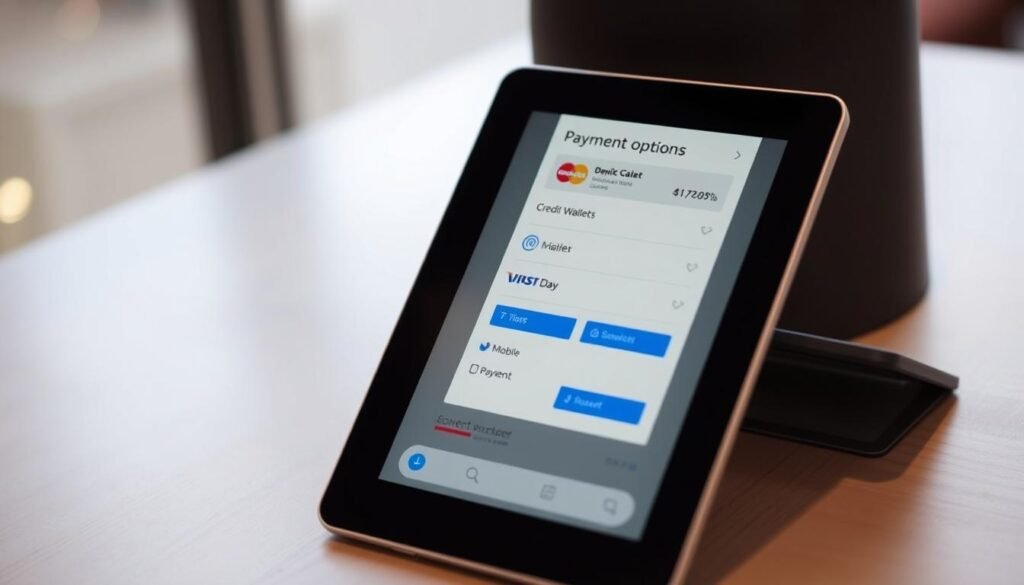Address
304 North Cardinal
St. Dorchester Center, MA 02124
Work Hours
Monday to Friday: 7AM - 7PM
Weekend: 10AM - 5PM
Address
304 North Cardinal
St. Dorchester Center, MA 02124
Work Hours
Monday to Friday: 7AM - 7PM
Weekend: 10AM - 5PM

Can you really launch a professional online store in just a few minutes? Yes, with the latest e-commerce solutions, it’s possible. You can create a fully functional online store quickly and easily, without needing to know a lot about technology.
Imagine being able to start selling your products online within minutes. This is thanks to user-friendly e-commerce platforms that make the process simple. Our step-by-step guide will help you through the quick e-commerce setup process. This ensures a hassle-free experience as you start your online business.
E-commerce has become key in today’s business world. More people are shopping online, so businesses need to keep up. This ensures they stay ahead in the market.
The online shopping world is getting bigger fast. This is thanks to new tech and how people shop now. Global e-commerce sales are rising fast and are expected to keep growing.
This growth is a big chance for businesses to reach more customers. By having an online store, you can sell to people all over the world.
Selling online has many advantages, such as:
Using these benefits can make your business stronger and more profitable. Experts say, « The future of retail is online. » This shows how important e-commerce is.
To make an easy online store and launch it quickly, you need to know e-commerce well. You should also know how to use the tools and platforms available.
Finding your niche is crucial for a successful e-commerce store. Your niche is the specific area of the market your products serve. It’s important to pick it well to reach the right customers.

To find a profitable niche, you must study current market trends. Look at what people want, what your competitors are doing, and where there are gaps. Tools like Google Trends and social media can help you see what’s popular.
Key areas to focus on include:
After finding a promising niche, you need to know who your customers are. Create buyer personas based on their age, interests, and how they shop.
Consider the following:
By combining market trend research with a deep understanding of your audience, you can build a successful e-commerce store. This will meet your customers’ needs, leading to a thriving online shop.
Choosing the right platform is key for a smooth e-commerce site creation. Your platform will shape your online store’s look and feel. It also affects how it works behind the scenes.
Many e-commerce platforms are popular for their ease, flexibility, and growth potential. Some top picks are:
Each platform has its own benefits. For example, Shopify is known for being easy to use. Magento, on the other hand, offers lots of customization options.
| Platform | Ease of Use | Scalability | Cost |
|---|---|---|---|
| Shopify | High | High | Medium to High |
| WooCommerce | Medium | High | Low to Medium |
| BigCommerce | High | High | Medium to High |
| Magento | Low to Medium | High | Low to High |
When picking an e-commerce platform, think about a few important things. These help make setting up your store easy and efficient. Consider:
As noted by
« The right e-commerce platform can make all the difference in your online business’s success. »
By looking at these factors and the available platforms, you can choose wisely. This choice will support your business goals and make setting up your store smooth.
A good domain name and reliable hosting are key for your online store. When starting your e-commerce business, focus on these to build a strong online presence.
Your domain name is the first thing customers see. A memorable domain name boosts your brand’s identity and helps customers find you. It should be simple to spell, say, and remember.
A study shows a good domain name can improve your brand’s trust and loyalty.
« A great domain name is like a great storefront – it invites people in and makes them want to stay. »
When picking a domain name, think about using keywords for SEO. But, keep it short and simple. A straightforward name works best.
After getting a domain name, find a reliable hosting service. Your host is key to keeping your site up and running smoothly. Here are important factors and top e-commerce hosts:

When choosing a host, think about your business needs and support level. A good host can greatly improve your store’s performance and customer happiness.
Setting up an e-commerce store quickly means focusing on looks and ease of use. A good design makes shopping better, helping customers find what they need. This can boost sales and make customers happier.
A good interface keeps customers interested. Make sure your store is easy to navigate, with clear categories and a fast search. This helps customers find what they’re looking for quickly.
Simple navigation and a responsive design are essential. Your store should work well on phones, tablets, and computers.
A good layout showcases your products well. Use a clean design that focuses on your products. High-quality images and clear descriptions help too.
Organising products into categories makes browsing easier. This helps customers find related items and shop more efficiently.
Adding your brand to your store’s design makes it look professional. Use your brand’s colours, logo, and fonts everywhere. This builds trust and reinforces your brand.
Being consistent with your brand is crucial. Use your brand elements on every page, from the homepage to checkout.
Adding products to your online store is key to a great shopping experience. It’s not just about uploading items. It’s also about telling a story that speaks to your audience.

Your product descriptions are more than just lists of features. They’re a chance to connect with customers on an emotional level. Focus on the benefits your product offers, not just its features.
For example, instead of saying « This t-shirt is made from cotton, » say « Wrap yourself in comfort with our cotton t-shirts, designed to keep you feeling fresh all day. »
« The right product description can turn a browser into a buyer. »
Efficient inventory management is vital for your e-commerce store’s success. It ensures products are available when customers want them, avoiding overselling or stockouts.
To manage your inventory well:
By following these steps, your e-commerce store will run smoothly. This will give your customers a better experience and help drive sales.
For a smooth shopping experience, your online store needs secure payment and reliable shipping. A fast website store launch relies on quick transaction processing and fast delivery.

It’s important to offer many payment options to meet customer needs. Popular secure payment gateways include:
These services have robust security features. They protect your business and customers from fraud.
Good shipping solutions are key for on-time delivery and happy customers. Here are some options:
Adding these shipping carriers to your instant e-commerce platform makes logistics smoother. It also speeds up delivery.
Secure payment gateways and efficient shipping together boost the shopping experience. This leads to more loyal customers and more business.
A good marketing plan is key for your online store’s success. With more people shopping online, a strong marketing strategy can help attract and keep customers.
Social media is a great way to promote your store. By sharing interesting content on Instagram, Facebook, and Twitter, you can boost your brand and bring more visitors to your site. Consistency is key in social media marketing.
Here are some tips for social media success:
Email marketing is a powerful tool to reach your customers directly. By growing your email list and sending out engaging campaigns, you can boost sales and build loyalty. As Marketing Pro says, « Email marketing is a vital part of any e-commerce strategy. »
« The money is in the list » is a common saying among marketers, showing how important it is to grow and care for your email list.
To make your email marketing better, focus on:
To check how well your e-commerce store is doing, you need to watch key numbers and use analytics tools. Starting an e-commerce store is just the first step. It’s important to understand how it’s doing to make smart choices and grow.
Look at things like conversion rates, average order value, and how well you keep customers coming back. These numbers show how well your store is doing. They help you find what needs work and how to get better.
Use tools like Google Analytics to learn more about your store. These tools give you important info on how customers act, sales patterns, and how well your marketing works. This helps you make your store even better.
By keeping an eye on how your store is doing and tweaking your plans, you can keep growing and doing well in the competitive e-commerce world.
The quickest way is to use a simple e-commerce platform. It should make creating your online store easy and fast. This way, you can start selling without much hassle.
Look at how customisable and scalable the platform is. Check if it supports various payment methods and integrates with other services. This ensures it fits your business needs and makes launching your store simple.
A professional store boosts your brand’s image and engages customers better. It also helps increase sales and revenue. These are key to a successful e-commerce business.
Use a trusted payment gateway with strong security features. It should encrypt and tokenise payments and follow industry standards like PCI-DSS. This keeps your customers’ data safe.
Track conversion rates, average order value, customer acquisition costs, and customer retention rates. These metrics show how well your store is doing. They help you make informed decisions based on data.
Use social media, email marketing, and other digital channels to reach your audience. This builds brand awareness and drives traffic to your store. It can increase sales and revenue.
A memorable domain name helps establish your brand’s identity. It makes it easier for customers to find and remember your store. This can improve brand recognition and customer loyalty.
Use an inventory management system to track stock levels and automate updates. It alerts you to low stock or out-of-stock items. This helps avoid overselling and stockouts.